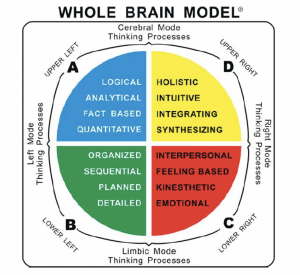

By Marty Gupta
TLG Vice President Strategic Services
Three million individuals have used the Herrmann Brain Dominance Instrument (HBDI®) to understand thinking preferences and harness Whole Brain® thinking. This intuitive tool has also been used by teams to improve communications and decision-making, resulting in increased diversity and inclusion, team effectiveness and productivity.
Building on ‘left and right-brain thinking’, the Whole Brain® Model adds upper (cerebral) and lower (limbic) thinking modes to create four quadrants:

Research, using the 120-question HBDI® diagnostic, has revealed that 90% of individuals have a dominance in two (i.e. 60% of individuals) or three (30%) of the four quadrants. For example, this individual is double-dominant in the A and D quadrants. They are more upper- and left-brained. (The dotted lines indicate how preferences change when the individual is under pressure.)

Brain dominance drives a person’s interests and preferences, motivations and ultimately their competencies. It should be noted that HBDI® measures mental preferences, not abilities or competencies, though one typically leads to the other.
In team applications, individuals are plotted on the map based on their preference weights. In this example, for a leadership team in the financial and banking industry, we see a high concentration in the A quadrant:

In this example, for a team of regional teaching coordinators, we see more diversity and lower-brain dominance:

Here are three examples of insights provided by HBDI that resulted in significant outcomes for our clients:
- Conflict Resolution – A large healthcare company used HBDI to reduce conflict on its executive team. Half of the team was found to be double-dominant, left-brain, and the other half was double-dominant, right brain. This awareness and Whole Brain® training helped pairs of individuals with different thinking preferences to improve communications and reduce disagreements.
- Diversity and Inclusion – The senior team of a leading technology company that was double-dominant, upper brain consistently missed product release dates. They created a new executive role and hired an individual with strong lower-brain preference, who had a dramatic impact on product quality and on-time delivery.
- Cross-Functional Collaboration – Executives in a fast-growing IT professional services company completed HBDI assessments along with their direct reports. They were surprised to find they had identical profiles to the individuals they hired, which contributed to a silo mentality in the company. New hiring and staff rotation practices increased cross-functional collaboration.
HBDI and the Whole Brain Model allow individuals and teams to identify thinking preferences and address gaps and biases. This awareness improves communications and collaboration, decision-making and productivity.


 Research, using the 120-question HBDI® diagnostic, has revealed that 90% of individuals have a dominance in two (i.e. 60% of individuals) or three (30%) of the four quadrants. For example, this individual is double-dominant in the A and D quadrants. They are more upper- and left-brained. (The dotted lines indicate how preferences change when the individual is under pressure.)
Research, using the 120-question HBDI® diagnostic, has revealed that 90% of individuals have a dominance in two (i.e. 60% of individuals) or three (30%) of the four quadrants. For example, this individual is double-dominant in the A and D quadrants. They are more upper- and left-brained. (The dotted lines indicate how preferences change when the individual is under pressure.)
 Brain dominance drives a person’s interests and preferences, motivations and ultimately their competencies. It should be noted that HBDI® measures mental preferences, not abilities or competencies, though one typically leads to the other.
In team applications, individuals are plotted on the map based on their preference weights. In this example, for a leadership team in the financial and banking industry, we see a high concentration in the A quadrant:
Brain dominance drives a person’s interests and preferences, motivations and ultimately their competencies. It should be noted that HBDI® measures mental preferences, not abilities or competencies, though one typically leads to the other.
In team applications, individuals are plotted on the map based on their preference weights. In this example, for a leadership team in the financial and banking industry, we see a high concentration in the A quadrant:
 In this example, for a team of regional teaching coordinators, we see more diversity and lower-brain dominance:
In this example, for a team of regional teaching coordinators, we see more diversity and lower-brain dominance:
 Here are three examples of insights provided by HBDI that resulted in significant outcomes for our clients:
Here are three examples of insights provided by HBDI that resulted in significant outcomes for our clients:

